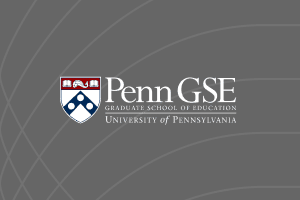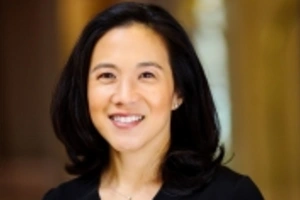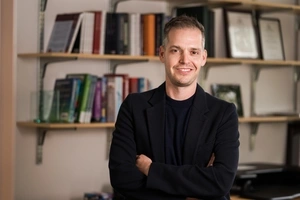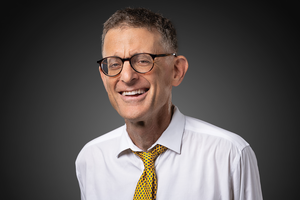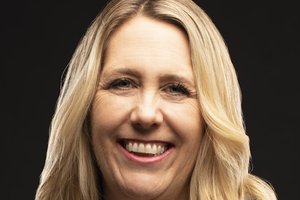Faculty Expert
Rand Quinn opened his first class after spring break, taught on video because the COVID-19 pandemic had closed Penn’s campus, with a simple question: “How should we best make use of our remaining time this semester?”
Up to that point, Quinn’s Research Practicum on Community Engagement class had been collaborating with Philadelphia teachers to create a curriculum about the importance of voting. But with students now checking in from their homes around the country, Quinn wanted their input on what, if anything, they should build, and how they should build it.
Quinn’s class decided their project needed to pivot.
Students still wanted to create a curriculum, and felt they needed to continue working with Philadelphia teachers to make their project useful. That choice was in keeping with the course’s Academically Based Community Service foundation. But seeing the challenges and opportunities of teaching online firsthand, the class chose to enfold the curriculum in a resource guide containing lessons for in person and online instruction. Students self-organized into work teams, determined tasks to be accomplished, and facilitated update and feedback sessions. Work will continue over the summer and the resource guide will be ready for teachers to use in the fall.
“We wanted to make the class meaningful,” Quinn said. “It took a little time, but when we tested the curriculum through video conferencing, it was really inspiring to see the high schoolers get into it, and my students were really excited to have this opportunity to connect with high schoolers. As a silver lining, we developed something that teachers will be able to use before the November election.”
When Quinn’s class first started researching what teens knew about voting, they saw national trends that young people were not engaged voters, so they began to design their curriculum around the evolution of voting rights, said Emily Chen, an Education Policy master’s student. But conversations with students from five Philadelphia high schools — George Washington Carver High School of Engineering and Science, Kensington Health Sciences Academy, Philadelphia Virtual Academy, West Philadelphia High School, and William L. Sayre High School — revealed that these juniors and seniors knew their history.
They wanted to know more, like the mechanics of how to register, and ways all the students in their class—citizens and non-citizens, those old enough to vote and those still too young—could engage in the process.
“They wanted something more oriented toward local issues,” Chen said. “Not just the national elections, but what’s happening with local issues, and issues that address them more directly. Hearing that, we were more committed to making that happen.”
Hearing the students’ voices
Chen and her classmates decided to incorporate more details about voter suppression, using both historical and modern examples. They also wanted to go beyond voting to talk to the students about different types of political action.
Quinn’s class came up with case studies of how community groups had worked to support or oppose policies in Philadelphia.
The message, according to Education, Culture, and Society master’s student Marissa Friedman, was that civic engagement doesn’t end with voting. Whatever their political beliefs, if young people want to make a difference, they need to stay informed and get organized.
Earlier in 2020, before the pandemic hit, there was a controversy around a proposed safe-injection facility in South Philadelphia. Supporters of the project said it would save lives being lost to the opioid epidemic. Opponents said the site would endanger the community. Having a relevant example—one that teachers could update and localize—gave the students a way into the discussion.
“We wanted an issue that was local, that kids would have feelings about, and potential opposing feelings without kids getting personal or political,” Friedman said.
The plan worked in test lessons delivered virtually, according to Elaine Kuoch, a history teacher at Carver High School of Engineering and Science.
“I really appreciated the way the Penn students tried to work with me,” said Kuoch, who is also a Penn GSE graduate. “They were really listening to my students and me, and where we were interested in the curriculum going. They heard what my students were passionate about and created something that engaged them.”
The Penn GSE students also observed how the Carver students were taking online classes, Kuoch said, and came up with modifications. For example, some students rarely turn on their camera, or will mute their audio so their classmates don’t hear household noise.
The Penn students built more chat-based discussions into their trial lesson. When they delivered it to Kuoch’s class, they found different students engaging in different ways. Instead of a barrier, the virtual classes created more entry points.
The shift to remote teaching forced Quinn and his students to think about how the in-person and virtual versions of their curriculum could reinforce good teaching practices. Quinn believes the finished product will be stronger because of it.
“The limitations of the virtual session created skills that can be translated to the live session,” Quinn said.
“I might have been able to start an in person lesson with a basic structure and think on the fly. But with a virtual class, I really had to think much more carefully about how I was structuring the class, and how I could set each and every student up for success. Those skills will be helpful in the traditional classroom too.”

